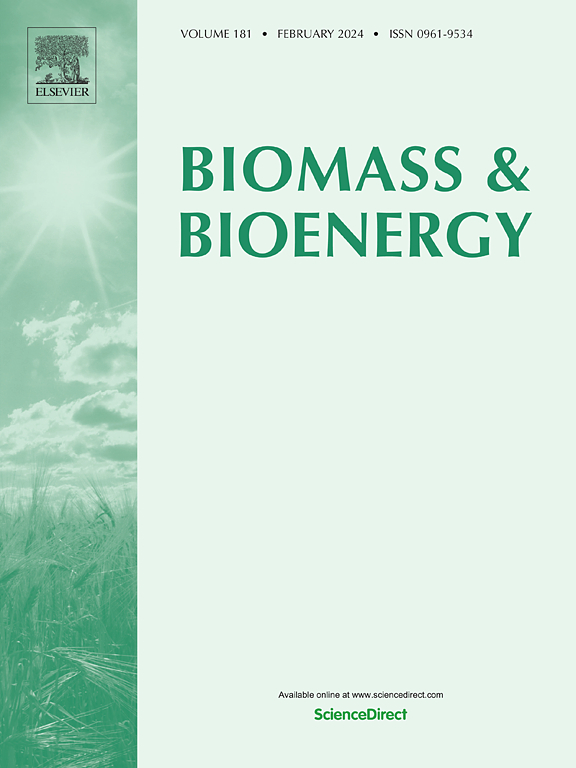Unveiling the biogas potential of raw Agave leaf juice: Exploring a novel biomass source
IF 5.8
2区 生物学
Q1 AGRICULTURAL ENGINEERING
引用次数: 0
Abstract
The use of plants from the Agave genus as biomass for biofuel presents great potential for energy transition due to its physiological traits and non-competitiveness with food crops. Brazil, the largest producer of sisal, presents a promising opportunity to use agave residues as substrate for anaerobic digestion. However, few studies address the potential for conversion of raw juice extracted from these plants into methane. This study evaluated the physicochemical and composition characteristics of raw agave juice, as well as its impacts on anaerobic digestion for biogas production and energy recovery. Biochemical Methane Potential assays were conducted with agave juice at concentrations of 0.5, 2.5, and 5 gVS/L, both with and without nutritional supplementation. The substrate concentration and nutritional supplementation increased methane production by 3.77- and 2-fold, respectively, showing that increasing substrate concentrations — at constant substrate/inoculum ratio — and nutritional supplementation significantly boosts methane production from agave. This optimization yielded methane yields of up to 626.97 ± 33.20 NmL CH4/gVS, along with 49.81 kWh of electric energy and 332.98 MJ of thermal energy for each ton of processed agave leaves. These findings enhance our understanding of optimizing biogas production from agave juice, supporting the transition to sustainable energy.

揭示龙舌兰叶原汁的沼气潜力:探索一种新的生物质来源
利用龙舌兰属植物作为生物燃料,由于其生理特性和与粮食作物的非竞争性,具有巨大的能源转换潜力。巴西是最大的剑麻生产国,利用龙舌兰残基作为厌氧消化的底物是一个很有前途的机会。然而,很少有研究解决从这些植物中提取的原汁转化为甲烷的潜力。本研究评价了龙舌兰原汁的理化性质和组成特征,以及其对厌氧消化产气和能量回收的影响。在添加和不添加营养的情况下,用浓度分别为0.5、2.5和5 gVS/L的龙舌兰汁进行生化甲烷电位测定。底物浓度和营养补充分别使龙舌兰的甲烷产量增加3.77倍和2倍,表明在底物/接种量恒定的情况下,增加底物浓度和营养补充显著提高了龙舌兰的甲烷产量。优化后,每吨龙舌兰叶片的甲烷产率可达626.97±33.20 NmL CH4/gVS,每吨龙舌兰叶片可产生49.81 kWh的电能和332.98 MJ的热能。这些发现增强了我们对优化龙舌兰汁沼气生产的理解,支持向可持续能源的过渡。
本文章由计算机程序翻译,如有差异,请以英文原文为准。
求助全文
约1分钟内获得全文
求助全文
来源期刊

Biomass & Bioenergy
工程技术-能源与燃料
CiteScore
11.50
自引率
3.30%
发文量
258
审稿时长
60 days
期刊介绍:
Biomass & Bioenergy is an international journal publishing original research papers and short communications, review articles and case studies on biological resources, chemical and biological processes, and biomass products for new renewable sources of energy and materials.
The scope of the journal extends to the environmental, management and economic aspects of biomass and bioenergy.
Key areas covered by the journal:
• Biomass: sources, energy crop production processes, genetic improvements, composition. Please note that research on these biomass subjects must be linked directly to bioenergy generation.
• Biological Residues: residues/rests from agricultural production, forestry and plantations (palm, sugar etc), processing industries, and municipal sources (MSW). Papers on the use of biomass residues through innovative processes/technological novelty and/or consideration of feedstock/system sustainability (or unsustainability) are welcomed. However waste treatment processes and pollution control or mitigation which are only tangentially related to bioenergy are not in the scope of the journal, as they are more suited to publications in the environmental arena. Papers that describe conventional waste streams (ie well described in existing literature) that do not empirically address ''new'' added value from the process are not suitable for submission to the journal.
• Bioenergy Processes: fermentations, thermochemical conversions, liquid and gaseous fuels, and petrochemical substitutes
• Bioenergy Utilization: direct combustion, gasification, electricity production, chemical processes, and by-product remediation
• Biomass and the Environment: carbon cycle, the net energy efficiency of bioenergy systems, assessment of sustainability, and biodiversity issues.
 求助内容:
求助内容: 应助结果提醒方式:
应助结果提醒方式:


